
Plan your visit
The Flight of the Liberty Bell 7
July 16, 2021
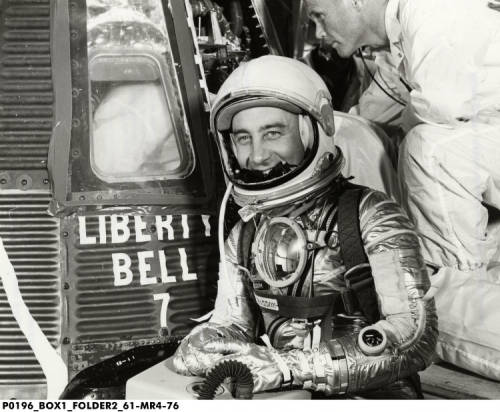
Early in the morning on July 21, 1961, a Redstone rocket blasted off from a launch pad at Cape Canaveral in Florida. At the top of the rocket in the tiny Mercury spacecraft sat a Purdue University graduate who had earned his wings as a pilot with the U.S. Air Force, flying approximately a hundred combat missions during the Korean War. One of seven men selected by the federal government to become the country’s first astronauts, Gus Grissom sat poised to become only the third man and second American to journey into space. His trip proved to be an eventful one.
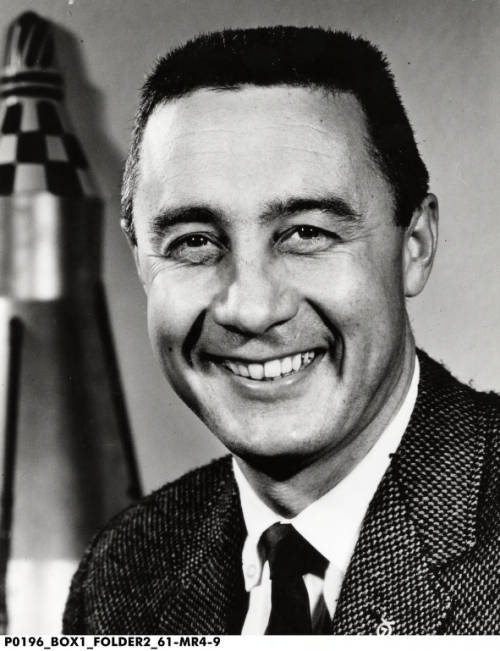
Born and raised in Mitchell, Indiana, Virgil I. “Gus” Grissom, became one of the original seven astronauts for the American space program in April 1959. Grissom graduated from Purdue University with a degree in mechanical engineering and flew a hundred missions in an F-86 fighter jet during the Korean War. NASA photo, Indiana Historical Society.
Born and raised in Mitchell, Indiana, Grissom, the son of a railroad signalman, had turned to flying for a career after receiving a degree in mechanical engineering from Purdue. After his service in Korea, Grissom had returned to the United States and had become a test pilot at the Wright-Patterson Air Force Base near Dayton, Ohio. He was still at the Dayton facility testing aircraft like the F-104 Starfighter on 4 October 1957, when the Soviet Union shocked the world by announcing it had successfully launched the first satellite, Sputnik, into space. The 184-pound satellite, the size of a basketball, could be heard by American tracking stations as it circled the globe making its “beep-beep” sound. The space race had begun.
After a few false starts (early American rockets had the disconcerting habit of blowing up), scientists managed to put the first U.S. satellite, Explorer 1, into orbit nearly four months after the Russians’ space success. As the public and politicians clamored for action, the United States initiated in 1958 its first man-in-space program, Project Mercury. President Dwight Eisenhower decided that the astronauts for the space program should come from the ranks of military-service test pilots, and the National Aeronautics and Space Administration asked the services to list their members who met specific qualifications. Approximately five hundred candidates qualified; one hundred and ten survived the initial screening process.
One of the pilots called to Washington, D.C., at the beginning of February 1959 to be evaluated as a possible astronaut was Grissom, who received the top-secret news from the adjutant at Wright-Patterson, who asked him, “Gus, what kind of hell have you been raising lately?” A confused Grissom expressed puzzlement over the question and learned that he had received orders to report to Washington wearing civilian, not military, attire. Before he left home, Grissom’s wife, Betty, thinking of the wildest possibility, prophetically asked him: “What are they going to do? Shoot you up in the nose cone of an Atlas [rocket]?” Reporting to the nation’s capital–he felt like he had “wandered right into the middle of a James Bond novel”—Grissom was ushered into a large reception room filled with men who were, he discovered after a brief time talking with them, fellow test pilots. From this group, a total of thirty-nine men, Grissom included, were sent to Lovelace Clinic in Albuquerque, New Mexico, to be probed and prodded by scientists. They later underwent pressure-suit tests, heat tests, acceleration tests, and vibration tests at the Aeromedical Laboratory of the Wright Air Development Center in Ohio.
From this torturous process, NASA picked seven to serve as Project Mercury astronauts and presented them to the public in April 1959. The American astronauts were, from the Marines, John Glenn; from the Navy, Walter Schirra, Alan Shepard, and Malcolm Scott Carpenter; and from the Air Force, Donald “Deke” Slayton, Gordon Cooper, and Grissom. The Hoosier flier had almost missed out on the historic designation when doctors during their wide-ranging tests discovered that Grissom suffered from hay fever. His pointed reply—“there won’t be any ragweed pollen in space”—saved him from being dropped from consideration.
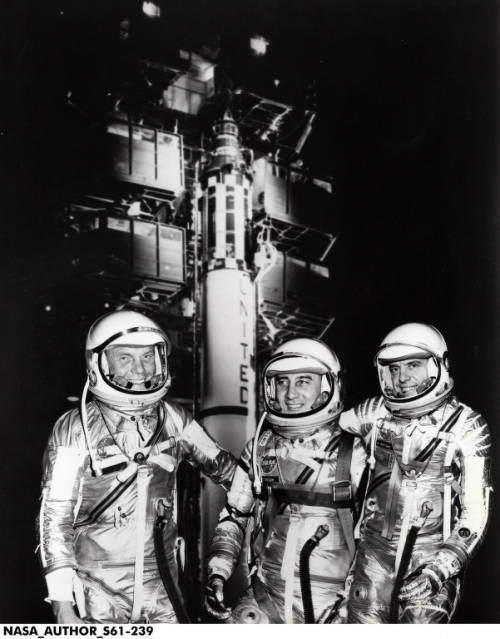
Astronauts Glenn, Grissom, and Shepard. NASA photo, Indiana Historical Society.
With his allergy problem out of the way, Grissom and his fellow astronauts underwent training to see which one, NASA confidently predicted, would be the first man in space. The astronauts, with the exception of Glenn, seemed more at ease with training for going into space than they did with dealing with the crush of media attention on them and their families. The media scrutiny would only grow as time went by. On January 19, 1961, Robert Gilruth, head of Project Mercury, confidentially informed the astronauts of the flight order: Shepard would be the first man to ride the Redstone rocket; Grissom had the second flight; and Glenn would be the backup for both missions.
It failed to work out as the American space agency had hoped; on April 12, 1961, Russian cosmonaut Yuri A. Gagarin made a one-orbit flight around the Earth that lasted one hundred and eight minutes in his Vostok spacecraft Swallow, winning for the Soviet Union the honor of being the first nation to put a human being into the inky void of space. Shepard followed Gagarin into space with his suborbital flight aboard Freedom 7 on May 5, 1961.
On the morning of his scheduled flight aboard his spacecraft, designated as the Liberty Bell 7, Grissom appeared calm and collected. During a last-minute physical, the doctor examining Grissom had been surprised at his subject’s low blood pressure. Grissom’s fifteen-minute, thirty-seven-second flight went off without a hitch, as his capsule made a successful splashdown in the Atlantic Ocean. From that point on, however, things began to go wrong.
As Grissom waited to be picked up by Marine helicopters from the carrier Randolph, he informed the chopper pilots that he would need three or four minutes to check the switch positions on his instrument panel. According to the recovery plan, the helicopter pilot was supposed to radio to Grissom as soon as he had lifted the capsule from the water. At that point, Grissom would remove his helmet, blow off the hatch, and exit the spacecraft.
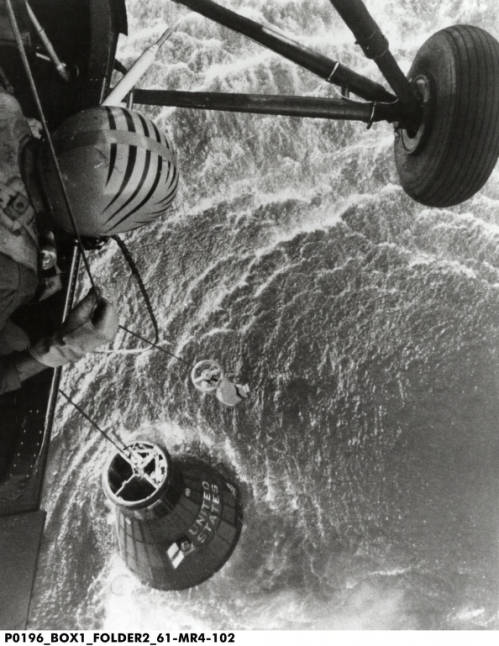
Grissom was lying flat on his back inside the capsule waiting to be picked up by a U.S. Marine helicopter when the hatch, due to a mechanical failure, blew off. Seawater flooded the “Liberty Bell 7” and Grissom escaped into the sea. NASA photo, Indiana Historical Society
“I had unhooked the oxygen inlet hose by now and was lying flat on my back and minding my own business,” Grissom recalled, “when suddenly the hatch blew off with a dull thud. All I could see was blue sky and seawater rushing in over the sill.” Tossing off his helmet, the astronaut hoisted himself through the hatch. “I have never moved as fast in my life,” said Grissom. “The next thing I knew I was floating high in my suit with the water up to my armpits.”
Although a helicopter managed to snag the capsule, it could not handle the weight of the waterlogged spacecraft and had to cut it loose; it was the first time in his long flying career that Grissom had ever lost an aircraft. (On July 20, 1999, undersea explorer Curt Newport raised the Liberty Bell 7 from its resting place on the ocean floor. Today the spacecraft is part of the collection of the Kansas Cosmosphere and Space Center in Hutchinson, Kansas.) Meanwhile, the astronaut was struggling to keep from drowning. Although his space suit kept out the water, he was losing buoyancy because of an open air-inlet port in the belly of his suit. As he fought to stay afloat, Grissom regretted the two rolls of dimes, three one-dollar bills, two sets of pilot’s wings, and some miniature models of the spacecraft he had stowed in the leg pocket of his spacesuit as souvenirs of his flight. “I thought to myself, ‘Well, you’ve gone through the whole flight, and now you’re going to sink right here in front of all these people,’” Grissom recalled.
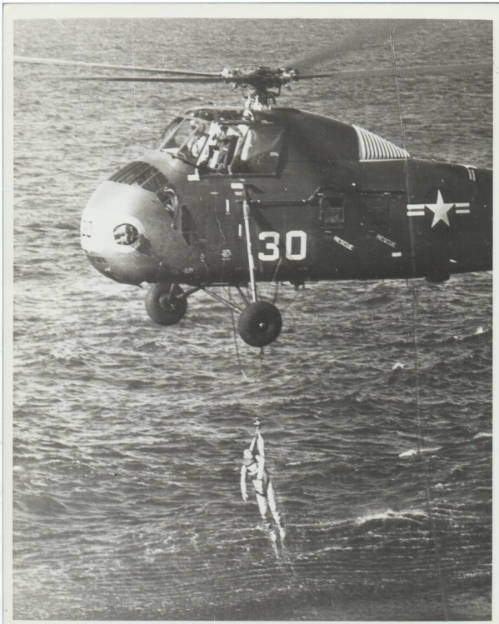
While helicopters attempted to recover the “Liberty Bell 7,” Grissom found that he was sinking beneath the waves. A helicopter finally rescued him. Onboard the USS Randolph, a crewman gave Grissom his helmet and said it was found “floating right next to a ten-foot shark.” NASA photo, Indiana Historical Society.
An exhausted Grissom finally managed to grab a horse collar by a helicopter, and found he had the strength once onboard to grab a Mae West life jacket and put it on for the flight back to the aircraft carrier. “I wanted to make certain that if anything happened to this helicopter I would not have to go through another dunking,” he said. Once Grissom was safely onboard the Randolph, an officer came up to him and handed him his space helmet, which had been plucked from the water by the crew of an escort destroyer. “For your information,” the officer told the astronaut, “we found it floating right next to a ten-foot shark.”
After his harrowing near drowning, Grissom had enough composure to call his wife from Grand Bahama Island. A relieved Betty Grissom lightheartedly informed her husband that she had heard he had “got a little bit wet.” Moving on to more serious matters, she asked him the crucial question: had he done anything wrong that contributed to the capsule’s sinking? “I did not do anything wrong,” Grissom emphatically replied. “That hatch just blew.” With that matter resolved for the moment, the astronaut calmly ended the conversation by asking his wife to bring some extra slacks and shirts with her when she met him in Florida.
Although an accident review panel cleared Grissom, and the other astronauts supported him, unanswered questions about the hatch dogged the Hoosier native for the rest of his career. In his book The Right Stuff by Thomas Wolfe and the movie of the same name based on the work, the author and filmmaker insinuated that Grissom panicked and had been to blame for the hatch coming off ahead of schedule. According to astronaut Gordon Cooper, these allegations were false.
“He [Grissom] did not screw up and lose his spacecraft,” Cooper said. “Later tests showed the hatch could malfunction, just as Gus said it did. A vacuum built up in the firing pin channels.” Sam Beddingfield, a NASA engineer responsible for the pyrotechnics and recovery system on the Mercury capsule and a friend of Grissom who believed in the astronaut’s courage and poise, thoroughly investigated the incident and discovered two ways in which the hatch could have blown in the manner described by Grissom. Even the actor who played the unlucky astronaut in the movie The Right Stuff, Fred Ward, expressed doubt about Grissom blowing the hatch on purpose. Ward learned that all the astronauts who did blow their hatches suffered bruised knuckles, and Grissom’s knuckles were not bruised.
“I think NASA sort of pointed the finger at him to take the blame off themselves for losing the capsule,” Ward said. “I don’t think he was responsible at all.”









